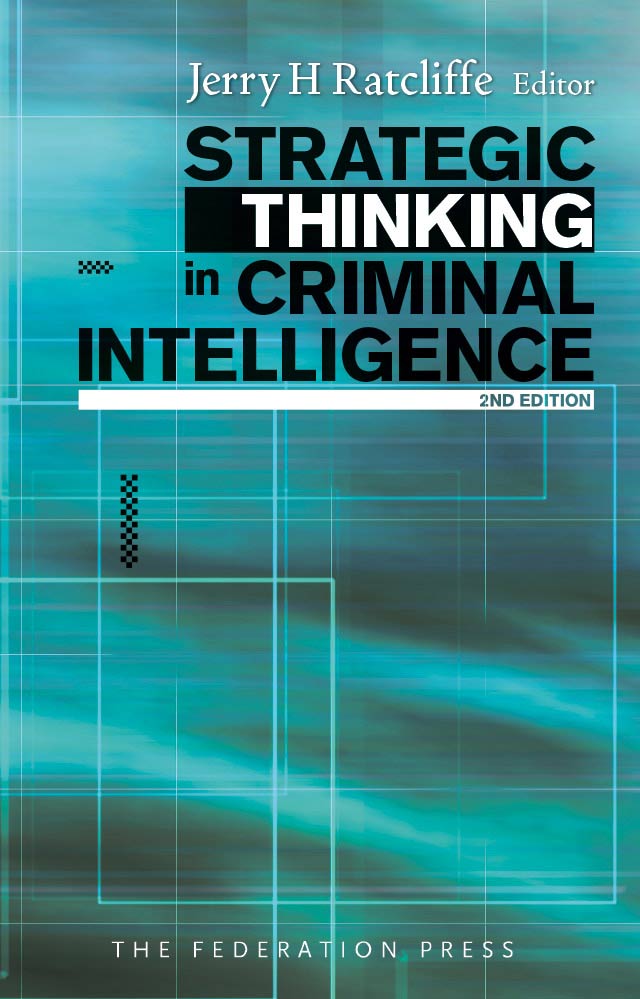This new edition of the best selling Strategic Thinking in Criminal Intelligence is designed to complement the drive for more strategic planning in law enforcement crime prevention and detection.
The criminal environment is one of rapid and significant change and to be effective, law enforcement is now required to make long-term predictions, anticipate broadly, and think strategically beyond tactical investigations and operational outcomes.
Expanded by three chapters, this new edition emphasises intelligence products, risk and threat assessments, and the unfolding complications of intelligence sharing. Expert authors drawn from intelligence agencies around the world provide a unique insight into the philosophy and practice of leading strategic criminal intelligence specialists
It is a vital resource for intelligence practitioners, crime analysts, law enforcement managers and advanced students of policing.
The structure of strategic thinkingJerry Ratcliffe Developments in Australian strategic criminal intelligenceKevin Rogers Developments in UK criminal intelligenceJohn Grieve Strategic aspects of the UK National Intelligence ModelBrian Flood and Roger Gaspar Task definitionJonathan Nicholl The theory and practice of intelligence collectionOliver Higgins Intelligence researchJerry Ratcliffe Exploratory intelligence toolsCorey E Heldon Threat and risk assessmentsNatasha Tusikov and Robert Fahlman Futures work in strategic criminal intelligenceNeil Quarmby Influencing decision-makers with intelligence and analytical productsR Mark Evans Project managementPatrick F Walsh Collaborative intelligence productionRay Guidetti A practitioner’s perspective of UK strategic intelligenceSteve Christopher and Nina CopeSetting the strategic agendaJerry Ratcliffe and James Sheptycki
Strategic Thinking in Criminal Intelligence is a work which should be considered by practitioners, policy makers and readers with an interest in law enforcement. When law enforcement agencies are continually under pressure to deliver more with even fewer resources, the field of strategic criminal intelligence has a role to play in the reduction, detection and prevention of crime.
Law Institute Journal(Victoria), March 2010
Reviews of the previous edition:
Strategic Thinking in Criminal Intelligence promotes the idea that the collective use of effective strategic planning in law enforcement is an important component of the intelligence cycle which may lead to the promotion of a “… stable political, civil and economic environment domestically and internationally.” … [It] is a collection of chapters by leading strategic intelligence analysts from across the global law enforcement community. Although the text is primarily aimed as a tool of reference for intelligence officers and researchers there is a loud warning resonating from the book. As a result of advanced technology available to both the good guys and the bad guys this text invites the reader to think about how the good guys can best stay one step ahead of the bad guys or be better prepared when inevitable international criminal activity happens.
NSW Police News, Vol 84(4), April 2004
The book is structured as a seamless synthesis of the theoretical and practical operational aspects of criminal intelligence. …
The book carves out a prominent niche for strategic crime intelligence in the edifice of law enforcement. The models prescribed advocate a strong, centralised intelligence effort, at the same time calling upon the local enforcers to gear up their operational and tactical capabilities. The articles are not only aimed at filling in the present intelligence gap and filling the existing vacuum, but also present models of perspective planning for the foreseeable future. This dimension gives us some valuable tips on the current thinking on the shape of things to come.
The existing literature on this vital area is scarce, inadequate and surprisingly under-researched until recently. In this respect, the book under review is actually a pioneering effort, which makes it a must-read for the decision makers and policy planners in the area of law enforcement.
Some of the presentations are quite theoretical, treating the project as a management exercise and analysing the complex interplay of the factors involved, which significantly impact the outcome. However, these articles, when juxtaposed with the actual experiences of the existing operating models in the UK and Australia, bring out the practical wisdom of the theoretical drill.
While the developed countries continue their research and experimentation on their criminal intelligence models, their experiences provide us with enriching insights, which could be a great help in evolving our own long overdue criminal intelligence mechanism. Senior decision makers – both in the bureaucracy and the police – will find this book an extremely valuable tool to understand the complexities of the problem and devise an efficacious criminal intelligence apparatus best suited to our needs and requirements.
Amit Varma IPS, Criminal Investigation Department Review, August 2004, 26
With contributions from both Australia and the United Kingdom, this is an interesting and well written study that should appeal to anyone involved in intelligence gathering and analysis within police circles.
Thames View, No 30, December 2005






